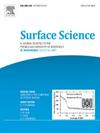First-Principles study on the effect of 3d transition metal atom doping on Cl adsorption on α-Fe(100) surface
IF 2.1
4区 化学
Q3 CHEMISTRY, PHYSICAL
引用次数: 0
Abstract
The effect of 3d transition metal atom doping on the chloride corrosion resistance of iron-based alloys is different. Under the aqueous solution environment simulated by the VASPsol method, the First-Principles method based on density functional theory was adopted to study the influences of 3d transition metal atoms (Sc, Ti, V, Cr, Mn, Co, Ni, Cu, Zn) doping on the work function, Cl adsorption energy and electronic structure of the α-Fe(100) surface. The results show that the doping of Sc, Ti, V, Cr, Mn, Co, Ni and Cu atoms can change the work function of the surface to varying degrees, while Zn doping has little effect on it. In the chlorine-containing water environment, the most stable adsorption site of Cl on the α-Fe(100) surface is affected by the atomic number arrangement of the doping atoms. Doping atoms with larger/smaller atomic numbers than Fe atoms reduce/increase the adsorption strength of Cl on the α-Fe(100) surface. The influence of doping atoms on the surface Cl adsorption energy is achieved by changing the bonding strength between Cl and the doped surface.

掺杂 3d 过渡金属原子对 α-Fe(100)表面 Cl 吸附影响的第一性原理研究
本文章由计算机程序翻译,如有差异,请以英文原文为准。
求助全文
约1分钟内获得全文
求助全文
来源期刊

Surface Science
化学-物理:凝聚态物理
CiteScore
3.30
自引率
5.30%
发文量
137
审稿时长
25 days
期刊介绍:
Surface Science is devoted to elucidating the fundamental aspects of chemistry and physics occurring at a wide range of surfaces and interfaces and to disseminating this knowledge fast. The journal welcomes a broad spectrum of topics, including but not limited to:
• model systems (e.g. in Ultra High Vacuum) under well-controlled reactive conditions
• nanoscale science and engineering, including manipulation of matter at the atomic/molecular scale and assembly phenomena
• reactivity of surfaces as related to various applied areas including heterogeneous catalysis, chemistry at electrified interfaces, and semiconductors functionalization
• phenomena at interfaces relevant to energy storage and conversion, and fuels production and utilization
• surface reactivity for environmental protection and pollution remediation
• interactions at surfaces of soft matter, including polymers and biomaterials.
Both experimental and theoretical work, including modeling, is within the scope of the journal. Work published in Surface Science reaches a wide readership, from chemistry and physics to biology and materials science and engineering, providing an excellent forum for cross-fertilization of ideas and broad dissemination of scientific discoveries.
 求助内容:
求助内容: 应助结果提醒方式:
应助结果提醒方式:


